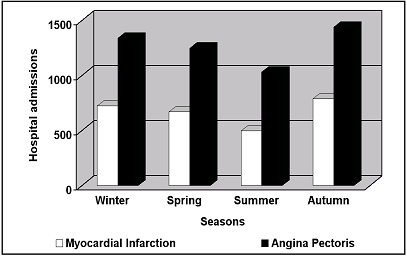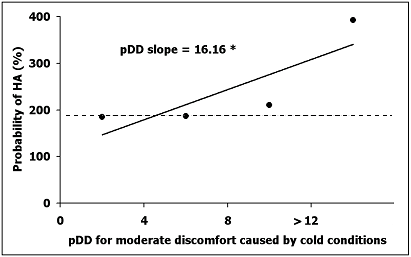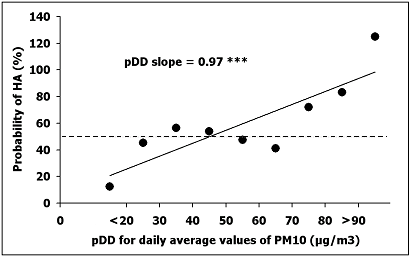
 |
||
| Scientists' Contributions | ||
A PRELIMINARY STUDY ON THE RELATIONSHIPS BETWEEN URBAN ENVIRONMENTAL PARAMETERS AND HOSPITAL ADMISSIONS FOR CARDIOVASCULAR DISEASES
Marco Morabito* ( ), Alfonso Crisci*, Lorenzo Cecchi** and Simone Orlandini**
), Alfonso Crisci*, Lorenzo Cecchi** and Simone Orlandini**
* Institute of Biometeorology - National Research Council - Via Caproni 8, 50145, Florence, Italy
** Interdepartmental Centre of Bioclimatology - University of Florence, Piazzale delle Cascine 18, 50144, Florence, Italy
( ) e-mail: m.morabito@ibimet.cnr.it o marcomorabito1@virgilio.it
) e-mail: m.morabito@ibimet.cnr.it o marcomorabito1@virgilio.it
This study is a part of a wider research called “Climate and Health” being carried out by the Institute of Biometeorology of the Italian National Research Council in Florence and the Interdepartmental Centre of Bioclimatology of the University of Florence. The work group, created in 2000, is composed of various researchers from the fields of meteorology and medicine, coordinated by Professors G.F. Gensini, G. Maracchi and V. Digiesi. The group has already presented a number of papers on their work at various national and international Congresses and also published several articles.
The effects on health of environmental parameters have been widely studied in recent years. A particular attention has been paid to people living in urban areas, where a high percentage of the population spend most of their time. Many environmental parameters, such as meteorological variables, air pollution, pollens and spores, are involved and the dynamics of their interrelationships are very complicated. However it is well known that several environmental conditions could represent aggravating circumstances especially for those people who are particularly sensitive to sudden changes in weather patterns, such as elderly people, or triggering off factors for specific diseases (Michelozzi et al., 2000; Díaz et al., 2002; Le Tertre et al., 2002; Sunyer et al., 2003).
During the last 20 years of the XX century, many epidemiological studies showed that environmental parameters have statistically significant effects on an increase mortality in particular and to a lesser extent morbidity. Those for cardiovascular and respiratory diseases have been the ones most studied.
Regarding hospital admissions (HA) for various pathologies, most of these researches have studied the influence of a single meteorological variable, in particular air temperature, but only a few studies have evaluated the effect of other parameters (Thompson et al., 1996; Danet et al., 1999). In these latter studies authors found associations with atmospheric pressure and relative humidity. In a recent study (Rusticucci et al., 2002), which took place in Argentina, the authors found that the application of biometeorological indices appear to represent the prevailing meteorological conditions well.
On the topic of air pollution, many recent researches (Biggeri et al., 2002; Le Tertre et al., 2002; Koken et al., 2003; Lin et al., 2003) have showed strong relationships between several pollutants (such as CO, PM10, O3, NO2 and SO2) and HA for cardiovascular diseases (CVD), in particular for people over 65 years old.
In the present preliminary study, for the period 1998-2002, HA, rather than mortality, have been considered in order to find daily-environmental discomfort conditions over which there is an increase in the probability of HA for a specific disease. Threshold values of biometeorological indices and the daily average or maximum values of several pollutants (CO, PM10 and O3) were assessed in order to evaluate weather and air pollution discomfort conditions. All this study was based on a new approach taking into consideration the effect of a “Discomfort Day” (DD), defined as a day which causes an impact on a specific disease in relation to threshold values of environmental parameters. We used daily HA data for CVD divided into two groups: a) Myocardial Infarction (MI); b) Angina Pectoris (AP). These data were classified by season (fig. 1A), sex and age (fig. 1B).

(A)

(B)
Figure 1: Distribution of HA by seasons (A) and by age groups (B).
Discomfort conditions caused by weather were evaluated by using biometeorological indices which combined several meteorological parameters, such as air temperature, relative humidity and wind speed. The main results were that discomfort caused by cold conditions, seems to have a higher influence on HA for CVD than discomfort caused by hot conditions. Indeed, only HA for MI showed statistically significant relationships with severe discomfort caused by hot conditions only during summer (fig. 2). On the other hand, regarding cold conditions, a high probability of HA was found for both AP and MI, even during spring (fig. 3) and autumn. The high statistically significant relationship shown in this study between cold conditions and HA for CVD is confirmed in many other studies, in particular those based on mortality events for CVD. In a recent study (Hajat and Haines, 2002) performed in London, authors found that the mean number of consultations for cardiovascular-related visits by elderly people (over 65) to general practitioners was higher in the cool-season months (October-March) than in the warm-season months (April-September).

Figure 2: Probability of hospital admissions (HA) for myocardial infarction of males < 65 during summer. On discomfort days with a number of hours of severe discomfort caused by hot conditions over 8 an average increase in the probability of HA of 14% in comparison to the daily average probability of HA was found. Legend: pDD = potential Discomfort Days; Continuous line = linear regression on the values of the probability of HA on pDD; Dotted line = daily average probability of HA of males < 65 during summer.

Figure 3: Probability of hospital admissions (HA) for angina pectoris of people > 65 during spring. The probability of HA reached the maximum increase of 108% on discomfort days with over 12 hours of moderate discomfort caused by cold conditions in comparison to the daily average probability of HA. Legend: pDD = potential Discomfort Days; Continuous line = linear regression on the values of the probability of HA on pDD; Dotted line = daily average probability of HA > 65 during spring.
Regarding discomfort conditions caused by air pollution, increases in daily maximum values of CO showed the highest number of statistically significant associations with HA for CVD in various seasons (fig. 4). In a recent study (Lin et al., 2003) carried out in São Paulo (Brazil) the authors found that only CO presented a statistically significant effect on ischemic cardiovascular emergency room visits. In detail the authors found that CO was associated with an increase of 6.4% in daily emergency room visits for AP or MI. On the other hand daily increases in O3 and PM10 were statistically significant when associated mainly with HA of elderly people, especially HA for AP (fig. 5). These results agree with those obtained in international (APHEA: European Air Pollution Health Effects Approach) and national (MISA: Metanalisi Italiana degli studi sugli effetti a breve termine dell’inquinamento atmosferico) projects which showed statistically significant relationships between increases in HA for CVD of people over 65 on days with increases in O3 and PM10 (Ballester et al., 2002; Biggeri et al., 2002; Le Tertre et al., 2002).

Figure 4: Probability of hospital admissions (HA) for myocardial infarction of people > 85 during spring. On discomfort days with a maximum level of CO > 3.5 mg/m3 an average increase in the probability of HA of 25% in comparison to the daily average probability of HA was found. Legend: pDD = potential Discomfort Days; Continuous line = linear regression on the values of the probability of HA on pDD; Dotted line = daily average probability of HA of people > 85 during spring.
These preliminary results have shown that meteorological factors and air pollution have a role in HA for CVD in Florence, with a different impact on people according to sex and age. Further study are needed even analysing the HA several days after a DD. In this way it will be possible to develop an operative weather watch/warning system, informing people at high risk and improving hospital assistance when weather discomfort conditions are forecast.

Figure 5: Probability of hospital admissions (HA) for angina pectoris of males 65 - 75 during summer. The probability of HA reached the maximum increase of 151% on discomfort days with an average level of PM10 > 90 μg/m3 in comparison to the daily average probability of HA. Legend: pDD = potential Discomfort Days; Continuous line = linear regression on the values of the probability of HA on pDD; Dotted line = daily average probability of HA of males 65 - 75 during summer.
Acknowledgements
The authors wish to thank Dr F. Giovannini of ARPAT-Firenze (Agenzia Regionale per la Protezione Ambientale della Toscana) for providing meteorological and air pollution data; Dr G. Pasquini and Mr S. Sinatti of A.O.C.-Firenze (Azienda Ospedaliera di Careggi) for providing hospital admission data.
References
Ballester F, Iniguez C, Perez-Hoyos S, Tenias JM. Particulate air pollution and health in Valencia (Spain) 1994-1996. Gac Sanit 2002; 16 (6): 464-79.
Biggeri A, Baccini M, Accetta G, Lagazio C, Estimates of short-term effects of air pollution in Italy. Epidemiol Prev. 2002; 26 (4): 203-305.
Danet S, Richard F, Montaye M, Beauchant S, Lemaire B, Graux C, Cottel D, Marécaux N, RD; Amouyel P. Unhealthy effects of atmospheric temperature and pressure on the occurrence of myocardial infarction and coronary deaths. Circulation 1999; 100: e1-e7.
Díaz J, García R, Velázquez de Castro F, Hernández E, López C, Otero A. Effects of extremely hot days on people older than 65 years in Seville (Spain) from 1986 to 1997. Int J Biometeorol 2002; 46: 145-149.
Hajat, S. and Haines, A. Associations of cold temperatures with GP consultations for respiratory and cardiovascular disease amongst the elderly in London. Int J Epidemiol 2002; 31: 825-830.
Koken PJ, Piver WT, Ye F, Elixhauser A, Olsen LM, Portier CJ. Temperature, air pollution, and hospitalisation for cardiovascular diseases among elderly people in Denver. Environ Health Perspect 2003; 111 (10): 1312-7.
Le Tertre A, Medina S, Samoli E, Forsberg B, Michelozzi P, Boumghar A, Vonk JM, Bellini A, Ayres JG, Sunyer J, Scwartz J and Katsouyanni K. Short-term effects of particulate air pollution on cardiovascular diseases in eight European cities. J Epidemiol Community Health 2002; 56 (10): 773-9.
Lin CA, Pereira LA, de Souza Conceição GM, Kishi HS, Dilani R, Braga AL, Saldiva PH. Association between air pollution and ischemic cardiovascular emergency room visits. Environ Res 2003; 92: 57-63.
Michelozzi P, Fano V, Forastiere F, Barca A, Kalkstein LS , Perucci CA. Weather conditions and elderly mortality in Rome during summer. World Meteorological Organization Bulletin 2000; 49 (4): 348-355.
Rusticucci M, Bettolli ML, Harris de los Angeles M. Association between weather conditions and the number of patients at the emergency room in an Argentine hospital. Int J Biometeorol 2002; 46: 42-51.
Sunyer J, Ballester F, Le Tertre A, Atkinson R, Ayres JG, Forastiere F, Forsberg B, Vonk JM, Bisanti L, Tenias JM, Medina S, Schwartz J, Katsouyanni K. Tha association of daily dioxide air pollution levels with hospital admissions for cardiovascular diseases in Europe (The Aphea-II study). European Heart J 2003; 24: 752-760.
Thompson DR, Pohl JEF, Tse YYS, Hiorns RW. Meteorological factors and the time of onset of chest pain in acute myocardial infarction. Int J Biometeorol 1996; 39: 116-120.
| Back to the top |
 |
||
| Scientists' Contributions | ||